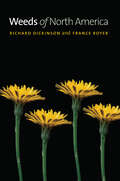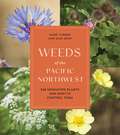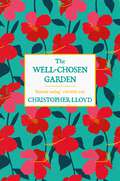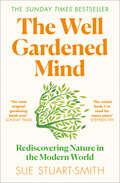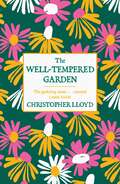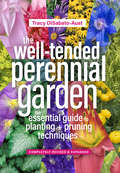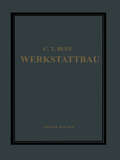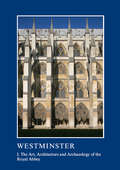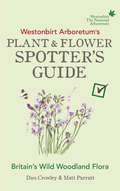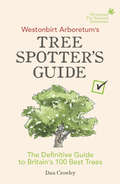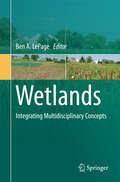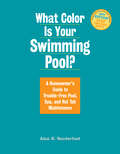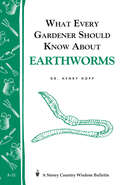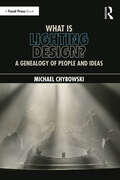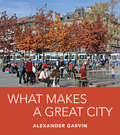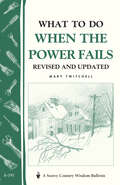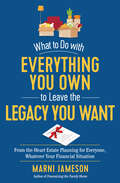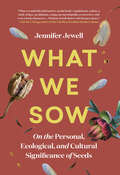- Table View
- List View
Weeds of North America
by Richard Dickinson France Royer“What is a weed,” opined Emerson, “but a plant whose virtues have not yet been discovered?” While that may be a worthy notion in theory, these plants of undiscovered virtue cause endless hours of toil for backyard gardeners. Wherever they take root, weeds compete for resources, and most often win. They also wreak havoc on industry—from agriculture to golf courses to civic landscape projects, vast amounts of money are spent to eradicate these virile and versatile invaders. With so much at stake, reliable information on weeds and their characteristics is crucial. Richard Dickinson and France Royer shed light on this complex world with Weeds of North America, the essential reference for all who wish to understand the science of the all-powerful weed. Encyclopedic in scope, the book is the first to cover North American weeds at every stage of growth. The book is organized by plant family, and more than five hundred species are featured. Each receives a two-page spread with images and text identification keys. Species are arranged within family alphabetically by scientific name, and entries include vital information on seed viability and germination requirements. Whether you believe, like Donald Culross Peattie, that “a weed is a plant out of place,” or align with Elizabeth Wheeler Wilcox’s “weeds are but unloved flowers,” Dickinson and Royer provide much-needed background on these intrusive organisms. In the battle with weeds, knowledge truly is power. Weeds of North America is the perfect tool for gardeners, as well as anyone working in the business of weed ecology and control.
Weeds of North America
by Richard Dickinson France Royer“What is a weed,” opined Emerson, “but a plant whose virtues have not yet been discovered?” While that may be a worthy notion in theory, these plants of undiscovered virtue cause endless hours of toil for backyard gardeners. Wherever they take root, weeds compete for resources, and most often win. They also wreak havoc on industry—from agriculture to golf courses to civic landscape projects, vast amounts of money are spent to eradicate these virile and versatile invaders. With so much at stake, reliable information on weeds and their characteristics is crucial. Richard Dickinson and France Royer shed light on this complex world with Weeds of North America, the essential reference for all who wish to understand the science of the all-powerful weed. Encyclopedic in scope, the book is the first to cover North American weeds at every stage of growth. The book is organized by plant family, and more than five hundred species are featured. Each receives a two-page spread with images and text identification keys. Species are arranged within family alphabetically by scientific name, and entries include vital information on seed viability and germination requirements. Whether you believe, like Donald Culross Peattie, that “a weed is a plant out of place,” or align with Elizabeth Wheeler Wilcox’s “weeds are but unloved flowers,” Dickinson and Royer provide much-needed background on these intrusive organisms. In the battle with weeds, knowledge truly is power. Weeds of North America is the perfect tool for gardeners, as well as anyone working in the business of weed ecology and control.
Weeds of North America
by Richard Dickinson France Royer“What is a weed,” opined Emerson, “but a plant whose virtues have not yet been discovered?” While that may be a worthy notion in theory, these plants of undiscovered virtue cause endless hours of toil for backyard gardeners. Wherever they take root, weeds compete for resources, and most often win. They also wreak havoc on industry—from agriculture to golf courses to civic landscape projects, vast amounts of money are spent to eradicate these virile and versatile invaders. With so much at stake, reliable information on weeds and their characteristics is crucial. Richard Dickinson and France Royer shed light on this complex world with Weeds of North America, the essential reference for all who wish to understand the science of the all-powerful weed. Encyclopedic in scope, the book is the first to cover North American weeds at every stage of growth. The book is organized by plant family, and more than five hundred species are featured. Each receives a two-page spread with images and text identification keys. Species are arranged within family alphabetically by scientific name, and entries include vital information on seed viability and germination requirements. Whether you believe, like Donald Culross Peattie, that “a weed is a plant out of place,” or align with Elizabeth Wheeler Wilcox’s “weeds are but unloved flowers,” Dickinson and Royer provide much-needed background on these intrusive organisms. In the battle with weeds, knowledge truly is power. Weeds of North America is the perfect tool for gardeners, as well as anyone working in the business of weed ecology and control.
Weeds of North America
by Richard Dickinson France Royer“What is a weed,” opined Emerson, “but a plant whose virtues have not yet been discovered?” While that may be a worthy notion in theory, these plants of undiscovered virtue cause endless hours of toil for backyard gardeners. Wherever they take root, weeds compete for resources, and most often win. They also wreak havoc on industry—from agriculture to golf courses to civic landscape projects, vast amounts of money are spent to eradicate these virile and versatile invaders. With so much at stake, reliable information on weeds and their characteristics is crucial. Richard Dickinson and France Royer shed light on this complex world with Weeds of North America, the essential reference for all who wish to understand the science of the all-powerful weed. Encyclopedic in scope, the book is the first to cover North American weeds at every stage of growth. The book is organized by plant family, and more than five hundred species are featured. Each receives a two-page spread with images and text identification keys. Species are arranged within family alphabetically by scientific name, and entries include vital information on seed viability and germination requirements. Whether you believe, like Donald Culross Peattie, that “a weed is a plant out of place,” or align with Elizabeth Wheeler Wilcox’s “weeds are but unloved flowers,” Dickinson and Royer provide much-needed background on these intrusive organisms. In the battle with weeds, knowledge truly is power. Weeds of North America is the perfect tool for gardeners, as well as anyone working in the business of weed ecology and control.
Weeds of the Pacific Northwest: 368 Unwanted Plants and How to Control Them
by Sami Gray Mark TurnerA comprehensive guide to the most common weeds of the Pacific Northwest, with essential information on their management and eradication Weeds are everywhere. They crowd out valuable agricultural crops, compete with the tomatoes and beans in your vegetable garden, spread rampantly along roadsides, and pop up from the tiniest cracks in sidewalks. In order to manage them, we must first learn how to identify them. Weeds of the Pacific Northwest is a guide to identifying, controlling, and eradicating over 300 species of weeds that gardeners and homeowners are likely to encounter in Northern California, Oregon, Washington, and British Columbia. Though they can all cause trouble, each weed is different. The hundreds of user-friendly photographs and detailed descriptions of each species here ensure that you can spot and treat any weed in your path. As the experts behind this book demonstrate, some plants can be killed by eating them, some by digging, some by smothering, and some only by the judicious application of chemical herbicides—and it is very important for you and your neighbors to know and understand the differences.
The Well-Chosen Garden
by Christopher LloydThe perfect book on how to make your garden the best it can be.'Essential reading' Country Life'Funny, encouraging, informative' Sunday TimesWould your garden, small or large, in town or country, win a prize? Is there room for improvement? Everybody has favourite plants, but the ability to put them all together to ensure a splendid show throughout the year is a skill that must be acquired. THE WELL-CHOSEN GARDEN will guide you to making the most of your available space, help you avoid untimely gaps, colour clashes and many other pitfalls of garden planning.The perfect book for new and experienced gardeners alike.
The Well Gardened Mind: Rediscovering Nature In The Modern World
by Sue Stuart-Smith‘The wisest book I’ve read for many years … Much more than a gardening book, much more than a guide to mental health … Hugely recommended’ Stephen Fry
The Well-Tempered Garden: A New Edition Of The Gardening Classic (Horticulture Garden Classics Ser.)
by Christopher LloydA timeless gardening classic by Christopher Lloyd, one of Britain's most highly respected plantsmen, updated for the 21st century. With a new foreword by Anna Pavord.This is a classic work by a gardener who combines a passionate love of his subject with a critical intelligence and a good helping of wit. THE WELL-TEMPERED GARDEN is packed with the sort of information keen gardeners crave - from planting, weeding and the pleasures of propagation to annuals, water lilies and vegetables. Hailed as a masterpiece when it was first published, THE WELL-TEMPERED GARDEN is as fresh, enlightening and necessary for gardeners in the 21st century as it was when it first appeared more than 40 years ago.
The Well-Tended Perennial Garden: The Essential Guide to Planting and Pruning Techniques, Third Edition
by Tracy DiSabato-AustThis completely revised third edition of the bestselling classic The Well-Tended Perennial Garden is a must-have ally in the quest for a beautiful, well-maintained garden.
Welwitschia (large print)
by RnibThis is an image, seen from the side, of a Welwitschia. It is a gymnosperm these are plants with cones, for example conifers. It is native only to the Nabib desert in Namibia and Angola and has no close relatives. There is a locator dot shown, which will be at the top left of the page when the image is the correct way up. The image has a dashed line image border.There is a cross section through desert soil stretching across the bottom quarter of the page.The plans roots branch out left and right through the soil from its very short woody stem in the bottom right of the page.Above this the image of the plant stretches across the bottom part of the page.It only has two twisted strap-like leaves throughout its life. They extend to the left and right from its stem. The leaf to the right extends beyond the image border. The leaves have two different textures (colours in Large Print). A lined texture (light green/brown) represents the top surface of the leaves and a fine dotted texture (dark green) the underside of the leaves. The twisted form of the leaves means that sections of both their top surfaces and the undersides can be found. These leave continue to grow throughout the plans life, becoming brown and frayed at their ends, and forming a tangled mass covering several square metres.The plant absorbs most of the water it needs through its leaves from the mists rolling in from the sea.The Welwitschia can live for more than 2000 years
Welwitschia (UEB contracted)
by RnibThis is an image, seen from the side, of a Welwitschia. It is a gymnosperm these are plants with cones, for example conifers. It is native only to the Nabib desert in Namibia and Angola and has no close relatives. There is a locator dot shown, which will be at the top left of the page when the image is the correct way up. The image has a dashed line image border.There is a cross section through desert soil stretching across the bottom quarter of the page.The plans roots branch out left and right through the soil from its very short woody stem in the bottom right of the page.Above this the image of the plant stretches across the bottom part of the page.It only has two twisted strap-like leaves throughout its life. They extend to the left and right from its stem. The leaf to the right extends beyond the image border. The leaves have two different textures (colours in Large Print). A lined texture (light green/brown) represents the top surface of the leaves and a fine dotted texture (dark green) the underside of the leaves. The twisted form of the leaves means that sections of both their top surfaces and the undersides can be found. These leave continue to grow throughout the plans life, becoming brown and frayed at their ends, and forming a tangled mass covering several square metres.The plant absorbs most of the water it needs through its leaves from the mists rolling in from the sea.The Welwitschia can live for more than 2000 years
Werkstattbau: Anordnung, Gestaltung und Einrichtung von Werkanlagen Nach Massgabe der Betriebserfordernisse
by Carl Theodor BuffDieser Buchtitel ist Teil des Digitalisierungsprojekts Springer Book Archives mit Publikationen, die seit den Anfängen des Verlags von 1842 erschienen sind. Der Verlag stellt mit diesem Archiv Quellen für die historische wie auch die disziplingeschichtliche Forschung zur Verfügung, die jeweils im historischen Kontext betrachtet werden müssen. Dieser Titel erschien in der Zeit vor 1945 und wird daher in seiner zeittypischen politisch-ideologischen Ausrichtung vom Verlag nicht beworben.
Westminster Part I: The Art, Architecture and Archaeology of the Royal Abbey (The British Archaeological Association Conference Transactions)
by Warwick Rodwell Tim Tatton-BrownThe British Archaeological Association’s 2013 conference was devoted to the study of Westminster Abbey and the Palace of Westminster. It also embraced Westminster School, which was founded at the Reformation in the Abbey precinct. Collectively, these institutions occupy a remarkable assemblage of medieval and later buildings, most of which are well documented. Although the Association had held a conference at Westminster in 1902, this was the first time that the internationally important complex of historic buildings was examined holistically, and the papers published here cover a wide range of subject matter. Westminster came into existence in the later Anglo-Saxon period, and by the mid-11th century, when Edward the Confessor’s great new abbey was built, it was a major royal centre two miles south-west of the City of London. Within a century or so, it had become the principal seat of government in England, and this series of twenty-eight papers covers new research on the topography, buildings, art-history, architecture and archaeology of Westminster’s two great establishments — Abbey and Palace. Part I begins with studies of the topography of the area, an account of its Roman-period finds and an historiographical overview of the archaeology of the Abbey. Edward the Confessor’s enigmatic church plan is discussed and the evidence for later Romanesque structures is assembled for the first time. Five papers examine aspects of Henry III’s vast new Abbey church and its decoration. A further four cover aspects of the later medieval period, coronation, and Sir George Gilbert Scott’s impact as the Abbey’s greatest Surveyor of the Fabric. A pair of papers examines the development of the northern precinct of the Abbey, around St Margaret’s Church, and the remarkable buildings of Westminster School, created within the remains of the monastery in the 17th and 18th centuries. Part II part deals with the Palace of Westminster and its wider topography between the late 11th century and the devastating fire of 1834 that largely destroyed the medieval palace. William Rufus’s enormous hall and its famous roofs are completely reassessed, and comparisons discussed between this structure and the great hall at Caen. Other essays reconsider Henry III’s palace, St Stephen’s chapel, the king’s great chamber (the ‘Painted Chamber’) and the enigmatic Jewel Tower. The final papers examine the meeting places of Parliament and the living accommodation of the MPs who attended it, the topography of the Palace between the Reformation and the fire of 1834, and the building of the New Palace which is better known today as the Houses of Parliament.
Westminster Part I: The Art, Architecture and Archaeology of the Royal Abbey (The British Archaeological Association Conference Transactions)
by Warwick Rodwell; Tim Tatton-BrownThe British Archaeological Association’s 2013 conference was devoted to the study of Westminster Abbey and the Palace of Westminster. It also embraced Westminster School, which was founded at the Reformation in the Abbey precinct. Collectively, these institutions occupy a remarkable assemblage of medieval and later buildings, most of which are well documented. Although the Association had held a conference at Westminster in 1902, this was the first time that the internationally important complex of historic buildings was examined holistically, and the papers published here cover a wide range of subject matter. Westminster came into existence in the later Anglo-Saxon period, and by the mid-11th century, when Edward the Confessor’s great new abbey was built, it was a major royal centre two miles south-west of the City of London. Within a century or so, it had become the principal seat of government in England, and this series of twenty-eight papers covers new research on the topography, buildings, art-history, architecture and archaeology of Westminster’s two great establishments — Abbey and Palace. Part I begins with studies of the topography of the area, an account of its Roman-period finds and an historiographical overview of the archaeology of the Abbey. Edward the Confessor’s enigmatic church plan is discussed and the evidence for later Romanesque structures is assembled for the first time. Five papers examine aspects of Henry III’s vast new Abbey church and its decoration. A further four cover aspects of the later medieval period, coronation, and Sir George Gilbert Scott’s impact as the Abbey’s greatest Surveyor of the Fabric. A pair of papers examines the development of the northern precinct of the Abbey, around St Margaret’s Church, and the remarkable buildings of Westminster School, created within the remains of the monastery in the 17th and 18th centuries. Part II part deals with the Palace of Westminster and its wider topography between the late 11th century and the devastating fire of 1834 that largely destroyed the medieval palace. William Rufus’s enormous hall and its famous roofs are completely reassessed, and comparisons discussed between this structure and the great hall at Caen. Other essays reconsider Henry III’s palace, St Stephen’s chapel, the king’s great chamber (the ‘Painted Chamber’) and the enigmatic Jewel Tower. The final papers examine the meeting places of Parliament and the living accommodation of the MPs who attended it, the topography of the Palace between the Reformation and the fire of 1834, and the building of the New Palace which is better known today as the Houses of Parliament.
Westonbirt Arboretum’s Plant and Flower Spotter’s Guide
by Dan Crowley Matt ParrattGet back to nature with this easy to use guide to Britain's greenery. From the experts at Westonbirt Arboretum in the depths of the Cotswolds, with one of the most beautiful gardens in the world, comes this beautiful pocket guide covering 100 popular wild plants and flowers.Categorised by type of plant, the simple layout ensures that this text is easy to use ‘on the go’. Meadow Saffron, Sweet Woodruff and Solomon’s Seal are just a few examples of the vibrant entries - each accompanied by two beautiful images and a short description.Illustrated with enchanting colour artwork, depicting each plant and their individual bloom or sprig, this covetable book will educate and entertain with text by two leading experts from the Arboretum and the Forestry Commission.
Westonbirt Arboretum’s Tree Spotter’s Guide: The Definitive Guide to Britain’s 100 Best Trees
by Dan CrowleyIn the depths of the Cotswolds, near Tetbury in Gloucestershire, lies one of the most beautiful tree gardens in the world, known as Westonbirt Arboretum. Here you can find around 15,000 trees, each one lovingly labelled. They offer the perfect, picturesque setting for escaping from the pressures of everyday life.Now, for the first time, 100 of the most popular British trees form the basis of this beautiful pocket guide. Illustrated with artwork depicting the tree and leaf, this covetable little book will educate and entertain with wonderfully concise text by one of the world’s leading tree experts from the Arboretum. Pop this book in your pocket for a great day out spotting some of the most celebrated features of our landscape!
Wetlands: Integrating Multidisciplinary Concepts
by Ben A. LePageThe science of wetlands and our understanding of these complex ecosystems have improved considerably. The emergence of multidisciplinary strategies is providing new opportunities and innovative approaches to address issues such as climate change and coastal protection. This book, with contributions from 19 specialists from academia, government, and industry, provides a trans-disciplinary approach to the understanding wetlands science, drawing together a wide range of expertise. Topics covered include the physical aspects that shape different wetlands around the world, as well as wetlands ecology, regulation, policy, and related social and economic issues.Featuring contributions from some of the world’s leading wetlands researchers and practitioners, this book provides an invaluable resource for undergraduate and post-graduate training in all aspects of wetlands management, conservation, and construction. It is also a useful auxiliary text for researchers working across disciplines in fields such as wetlands science, law, landscape architecture, environmental engineering, conservation ecology, and related disciplines.
What Color Is Your Swimming Pool?: A Homeowner's Guide to Trouble-Free Pool, Spa, and Hot Tub Maintenance
by Alan SanderfootKeep your swimming pool, spa, or hot tub clean and inviting with beautiful sparkling water. Covering all essential maintenance procedures, this easy-to-use guide shows you how to expertly and inexpensively care for your backyard water features. With advice on everything from basic cleaning routines to doing your own repairs, Alan E. Sanderfoot tells you what you need to know about water filtration systems, pumps, motors, heaters, winterizing, and more. Enjoy the pleasures of healthy, crystal-clear water for less money and less trouble! This publication conforms to the EPUB Accessibility specification at WCAG 2.0 Level AA.
What Every Gardener Should Know About Earthworms: Storey's Country Wisdom Bulletin A-21 (Storey Country Wisdom Bulletin)
by Henry HoppSince 1973, Storey's Country Wisdom Bulletins have offered practical, hands-on instructions designed to help readers master dozens of country living skills quickly and easily. There are now more than 170 titles in this series, and their remarkable popularity reflects the common desire of country and city dwellers alike to cultivate personal independence in everyday life.
What Is Lighting Design?: A Genealogy of People and Ideas
by Michael ChybowskiWhat Is Lighting Design?: A Genealogy of People and Ideas explains what lighting design is by looking at the history of ideas that are a part of this craft and how those ideas developed. Lighting design began in the West with the Renaissance, and each historical period since then has modified how and why light is used in performance, the methods for producing light, and the consensus around what its purpose is. Exploring each lighting design era and the basic components of lighting design, the book discusses how the central ideas of this craft developed over the past 500 years, what today’s lighting designers are concerned with, and how lighting design contributes to performances. This book is designed as a main course text for History of Lighting Design university courses and a supplementary text for and Introduction to Lighting Design, Stagecraft, and Scenography courses. It will also be of interest to directors, choreographers, and working lighting designers who wish to explore the history and meaning of their craft.
What Is Lighting Design?: A Genealogy of People and Ideas
by Michael ChybowskiWhat Is Lighting Design?: A Genealogy of People and Ideas explains what lighting design is by looking at the history of ideas that are a part of this craft and how those ideas developed. Lighting design began in the West with the Renaissance, and each historical period since then has modified how and why light is used in performance, the methods for producing light, and the consensus around what its purpose is. Exploring each lighting design era and the basic components of lighting design, the book discusses how the central ideas of this craft developed over the past 500 years, what today’s lighting designers are concerned with, and how lighting design contributes to performances. This book is designed as a main course text for History of Lighting Design university courses and a supplementary text for and Introduction to Lighting Design, Stagecraft, and Scenography courses. It will also be of interest to directors, choreographers, and working lighting designers who wish to explore the history and meaning of their craft.
What Makes a Great City
by Alexander GarvinThis volume will help readers understand that any city can be changed for the better and inspire entrepreneurs, public officials, and city residents to do it themselves.
What to Do When the Power Fails: Storey's Country Wisdom Bulletin A-191 (Storey Country Wisdom Bulletin)
by Mary TwitchellSince 1973, Storey's Country Wisdom Bulletins have offered practical, hands-on instructions designed to help readers master dozens of country living skills quickly and easily. There are now more than 170 titles in this series, and their remarkable popularity reflects the common desire of country and city dwellers alike to cultivate personal independence in everyday life.
What to Do with Everything You Own to Leave the Legacy You Want: From-the-Heart Estate Planning for Everyone, Whatever Your Financial Situation
by Marni JamesonFrom the author of bestselling, award-winning books on downsizing your home, here now is an all-in-one estate-planning guide for everyone, from those with little to those with much—all you need to know and do to make a difference in the lives of those you love and on the world, and turn whatever you possess into an intentional, meaningful legacy
What We Sow: On the Personal, Ecological, and Cultural Significance of Seeds
by Jennifer JewellAn insightful, personal, and timely exploration into the wonderful world of seeds. In What We Sow, Jennifer Jewell brings readers on an insightful, year-long journey exploring the outsize impact one of nature's smallest manifestations—the simple seed. She examines our skewed notions where "organic" seeds are grown and sourced, reveals how giant multinational agribusiness has refined and patented the genomes of seeds we rely on for staples like corn and soy, and highlights the efforts of activists working to regain legal access to heirloom seeds that were stolen from Indigenous peoples and people of color. Throughout, readers are invited to share Jewell's personal observations as she marvels at the glory of nature in her Northern California hometown. She admires at the wild seeds she encounters on her short daily walks and is amazed at the range of seed forms, from cups and saucers to vases, candelabras, ocean-going vessels, and airliners. What We Sow is a tale of what we choose to see and what we haven't been taught to see, what we choose to seed and what we choose not to seed. It urgently proves that we must work hard to preserve and protect the great natural diversity of seed.
